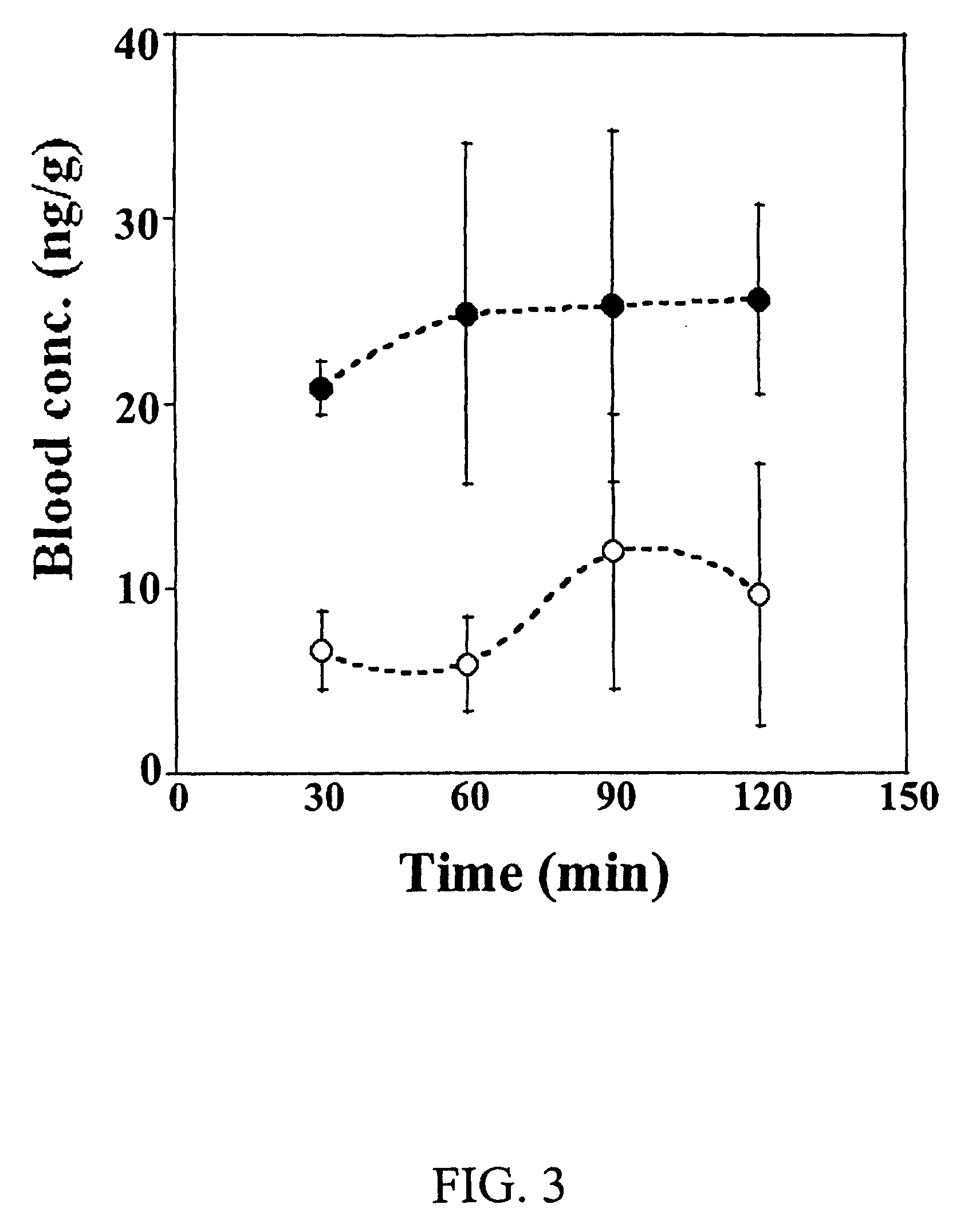Cyclodextrin nanotechnology for ophthalmic drug delivery
a cyclodextrin nanotechnology and ophthalmic technology, applied in the field of cyclodextrin nanotechnology for drug delivery, can solve the problems of limited amount of cyclodextrin that can be included in drug formulations, limited concentration and bioavailability, and low complexation efficacy of cyclodextrins, in general very low and their molecular weight is rather high
- Summary
- Abstract
- Description
- Claims
- Application Information
AI Technical Summary
Benefits of technology
Problems solved by technology
Method used
Image
Examples
experiment 1
[0107]Aqueous isotonic solution contained 0.5% [1,2,4,6,7-3H]-dexamethasone, 5.3% randomly methylated β-cyclodextrin DS 1.8, benzalkonium chloride (0.02%), EDTA (0.10%), hydroxypropyl methylcellulose (0.10% w / v) and sodium chloride (0.72%), all w / v %. This solution (50 μl) was administered to three groups of rabbits (3×6 rabbits) as eye drops to the left eye only, as nasal spray and as intravenous injection. Blood samples were collected every 30 minutes after drug administration and the rabbits sacrificed after 2 hours. Then both eyes were removed and the dexamethasone concentration determined in blood, cornea, anterior sclera, aqueous humor, lens, iris-ciliary body, vitreous humor, retina, optic nerve and urine, using a liquid scintillation counter. The relative contribution of topical permeation versus systemic delivery was determined by comparing the dexamethasone concentrations in the left and the right eyes after different routes of drug administration.
[0108]Results and conclus...
experiment 2
[0109]The purpose of this study was to investigate ocular irritation in rabbits following powder administration.
[0110]Methods: Timolol maleate powder was administered to one eye of each rabbit and the other eye was used as control. Both pure timolol maleate powder and freeze-dried with PVP-polymer (2.4% of mass) were tested in 1.0 mg (n=3) and 0.1 mg (n=6) doses. Additionally, four rabbits received 0.1 mg of the pure powder 3 times a day for 8 days. Redness of bulbar conjunctivae and the amount of discharge were rated from photographs (0-3 points, randomized and masked evaluation). Slitlamp examination was also performed. Hematoxylin-eosin (H&E) stained sections of eyes were examined with a light microscope following the 8 days experiment.
[0111]Results: No serious or irreversible signs of irritation were noted. There was no detectable difference between irritations from pure or freeze-dried powder. The table shows results for pure powder (median and range) (Table 2). Slitlamp examin...
experiment 3
[0114]The purpose of this study was to investigate the concentration of dexamethasone in various eye tissues after topical administration of 0.5 and 1.5% (w / v) dexamethasone solutions containing randomly methylated β-cyclodextrin as solubilizer.
[0115]Materials: [1,2,4,6,7-3H]-dexamethasone in ethanol solution with specific activity of 88 Ci / mmol was purchased from Amersham Biosciences. Dexamethasone was purchased from Sigma (Germany) and Bufa (Netherlands). Randomly methylated β-cyclodextrin with degree of substitution 1.8 (RMβCD) was purchased from Wacker-Chemie GmbH (Germany). Analytical grade of disodium edetate dihydrate (EDTA) was purchased from Merck (Germany). Hydroxypropyl methylcellulose (HPMC) was obtained from Mecobenzon (Denmark). Benzalkonium chloride was purchased from Sigma (USA). Soluene®-350 solubilizer, and liquid scintillation cocktails Hionic Fluor™ and Ultima Gold™ were purchased from Perkin Elmer (UK). All other chemicals used in this study were commercially av...
PUM
| Property | Measurement | Unit |
|---|---|---|
| size | aaaaa | aaaaa |
| diameter | aaaaa | aaaaa |
| volume | aaaaa | aaaaa |
Abstract
Description
Claims
Application Information
 Login to View More
Login to View More - R&D
- Intellectual Property
- Life Sciences
- Materials
- Tech Scout
- Unparalleled Data Quality
- Higher Quality Content
- 60% Fewer Hallucinations
Browse by: Latest US Patents, China's latest patents, Technical Efficacy Thesaurus, Application Domain, Technology Topic, Popular Technical Reports.
© 2025 PatSnap. All rights reserved.Legal|Privacy policy|Modern Slavery Act Transparency Statement|Sitemap|About US| Contact US: help@patsnap.com



